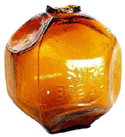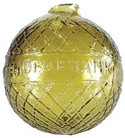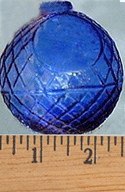|
Target Balls, a Sure-Fire Hit with Gunneys and Collectors Alike!
By Wayne Gilbert
Target balls are virtually unknown to many otherwise knowledgeable
collectors, but once they are discovered, sure as shootin', they are going to be
a hit! Originally costing about a penny apiece, they now can fetch as much as
$14,850 a fact that will get the attention of any collector.
These balls
are not to be confused with the balls filled with paint used by modern day war
games enthusiasts, which are also called target balls. Not only are the new
target balls made for a different use, but some are even reusable, something not
even remotely possible with the collectable target balls of the 19th century.
The target balls coveted by collectors were first used in the 1870s by duck
hunters vying to demonstrate their shooting skills. These colorful glass balls
are about the size and shape of a large Christmas tree ornament, (the most
common being 2 5/8" to 2 ?" in diameter) and are about as fragile. They were the
precursor of the saucer-shaped clay targets, commonly referred to as clay
pigeons, used by the target shooters of today.
Originally, these balls were
smooth and probably light-colored. Shotgun pellets bounced wildly off their
surface, if and when a shooter could see the ball clearly enough to hit one.
Soon these smoothies were replaced with embossed or quilted balls, most commonly
amber in color. These were more readily seen and shattered, but still did not
provide the challenge of a live bird as a target. In 1877, a mechanical thrower
was invented that could launch these fragile balls into the air without
destroying them. Soon, the use of multiple hidden throwers, which would throw
them in random and unexpected trajectories, made these balls a successful
challenge for sport shooters.
Target balls were made to sell for about a
penny apiece by a number of glass factories in the eastern U.S., as well as
Canada and parts of Europe. Because they were so inexpensive and made to be
destroyed, little care was given to their construction. They were frequently
deformed, and nearly all have broken or jagged necks where they were hurriedly
twisted from the glass blower's pipe. The only requirement for a good target
ball was that it is easily seen and very easily broken, so the thinness of the
glass was frequently stressed when describing them to shooters.
Wooden
barrels filled with target balls packed in sawdust, were soon seen at all
respectable shooting competitions, and just as quickly, manufacturers were
embossing their names, or the names of their retailers, across the balls. Balls
of many colors began appearing. Any color that could be readily seen against the
sky background was acceptable, but amber remained the most popular, followed by
various shades of blue.
Sharpshooters were always a favorite attraction at
the Wild West shows in 1800s, and shooters like Annie Oakley soon began using
target balls filled with feathers or colored paper streamers that seemed to
explode when hit by a bullet or buckshot. Ms. Oakley became so proficient at
shooting target balls that she claimed to have hit 4,472 of 5,000 glass balls in
midair at one exhibition. Her accomplishment was even more impressive when it
was announced she was shooting at the balls with a .22 caliber rifle.
Other
sharpshooters also set a high standard for hitting these balls in midair, some
alternating between several guns to keep the guns' barrels from overheating. One
of these shooters was W. F. "Doc" Carver, who is claimed to have been the most
prolific commercial buffalo hunter of all time. Doc Carver toured both the U.S.
and Europe giving shooting exhibitions and warding off challengers to his claim
to have been the greatest target ball shooter of his era.
Because these
balls would shatter when hit, glass fragments and missed balls did present a
hazard to any livestock or small boys' bare feet crossing the target area after
a shooting competition. By the 1880s, the use of target balls was on the
decline, being replaced with the more biodegradable clay pigeon. Soon, they were
showing up in grandmothers' sewing baskets as an aid to repairing holey socks or
being hung on Christmas trees with twisted wire or hairpins as cheap and
colorful ornaments.
These balls present a greater challenge to today's
collector than they did to the 19th century shooter. Because they were made to
be destroyed, they are extremely rare today and often are not recognized when
found in boxes of old Christmas ornaments. Another challenge for collectors is
that they were made in a variety of hues and colors and with a number of
different patterns and names embossed on them. Even the stems and shapes of the
balls varied, creating a seemingly endless variety of balls. And then there are
the other balls that are mistakenly identified as target balls, such as lighting
rod balls, fishing net balls and even some artificial hen's eggs that have been
offered for sale to target ball collectors.
Prices range from over a hundred
dollars for a common amber or blue ball to thousands of dollars for the rare or
one-of-a-kind ball. Even a ball that was misshapen in manufacture is collectable
and might bring a worthy price. Because of their low cost and lack of value when
new, barrels of these balls were simply abandoned in the back of warehouses and
old gun and hardware stores. It has happened that a rare ball worth a commanding
price one day will be comparatively worthless the next after the discovery of
one of these abandoned barrels containing hundreds of identical balls
identical to each other and identical to the once rare ball.
Target balls
that sold for the highest prices in a 2003 auction were from Canada (a golden
yellow amber target ball in diamond pattern by the Rutherford & Company
Hamilton Ontario, $1,800) and from England (a medium yellow amber in diamond
pattern from WW Greener St. Mary's Works, $1,100.)
With prices beginning at
just over a hundred dollars, why are some target balls selling for $10,000 and
more? Collectors will always answer that condition and rarity set the current
value for a collectible, not to mention the unmentionable: investment. The
future top value for target balls may be higher than today's prices, but that is
a real gamble with the volatility of the supply of these balls. More likely is
the fact that many target ball collectors seem to subscribe to the feeling that
by increasing the value of a rare or unusual ball, the price of all the more
common balls will also increase.
Sure Break target balls are among the most
valuable, and they have one other factor that contributes to their value their
beautiful design. There is no doubt that the Sure Break's design made it
difficult to manufacture, but does that design make a glass target ball's worth
over $10,000? Some collectors are saying, "Yes."
It takes perseverance to be
a target ball collector, along with a degree of courage to pay the asking price
of that "rare" ball needed to enhance a collection. A so-called rare ball today
could wind up being only useful as a decorative Christmas tree ornament
tomorrow. But if that should happen, sure as shooting, it will be the prettiest
ornament on the tree, by a long shot!
Wayne Gilbert always has
an eye for rare and unique collectibles. He lives in Westminster, Colorado (a
Denver suburb), and his wife tells people that he "collects anything that
collects dust." His personal taste runs to 1953 Kaiser cars, 1920's battery
radios, clocks and watches made by the A.C. Gilbert Company, and unusual
phonograph records. Wayne says he spends much of his time "researching
historical items/events that are of no practical value to anyone. In my 'real'
life, I was a data processing professional for 25 years and managed a living
history farm for five years, and I have been freelance writing for about 10
years."
|

The $10,000 Sure Break target ball. (Photo, Ralph Finch.)

Target balls were blown fast and were cheap, evidenced by the broken rim.

Target balls were first used
in the 1870s.
|